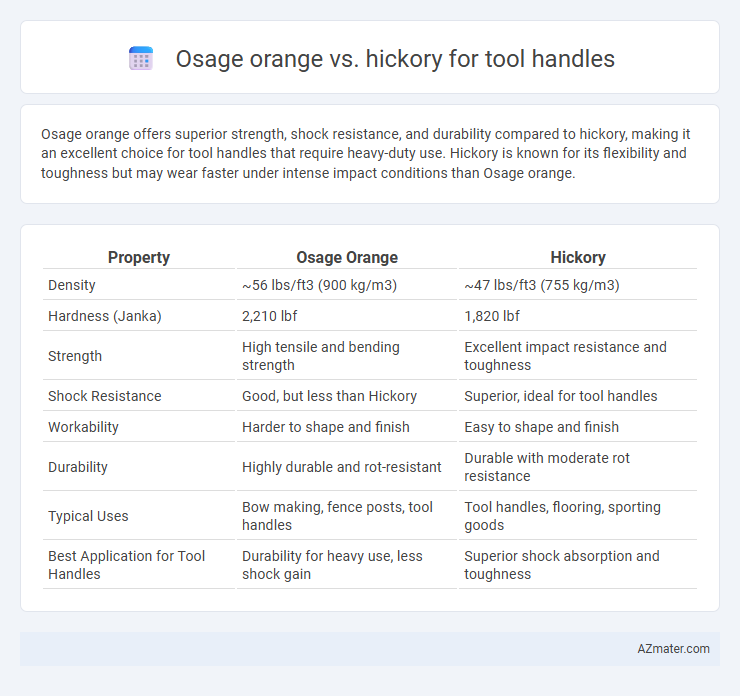Osage orange offers superior strength, shock resistance, and durability compared to hickory, making it an excellent choice for tool handles that require heavy-duty use. Hickory is known for its flexibility and toughness but may wear faster under intense impact conditions than Osage orange.
Table of Comparison
| Property | Osage Orange | Hickory |
|---|---|---|
| Density | ~56 lbs/ft3 (900 kg/m3) | ~47 lbs/ft3 (755 kg/m3) |
| Hardness (Janka) | 2,210 lbf | 1,820 lbf |
| Strength | High tensile and bending strength | Excellent impact resistance and toughness |
| Shock Resistance | Good, but less than Hickory | Superior, ideal for tool handles |
| Workability | Harder to shape and finish | Easy to shape and finish |
| Durability | Highly durable and rot-resistant | Durable with moderate rot resistance |
| Typical Uses | Bow making, fence posts, tool handles | Tool handles, flooring, sporting goods |
| Best Application for Tool Handles | Durability for heavy use, less shock gain | Superior shock absorption and toughness |
Introduction to Osage Orange and Hickory
Osage orange (Maclura pomifera) is a dense, tough hardwood known for its resistance to wear and shock, making it an excellent choice for tool handles requiring durability and strength. Hickory (Carya spp.) is widely regarded for its exceptional toughness, shock absorption, and flexibility, often preferred in traditional tool handles such as hammers and axes. Both woods offer remarkable impact resistance, with Osage orange providing higher density and natural rot resistance, while hickory delivers superior shock absorption and workability.
Historical Use in Tool Handles
Osage orange and hickory have both been historically prized for tool handles due to their exceptional strength and durability; Osage orange wood, known for its high density and resistance to wear, was traditionally favored by Native Americans and early American settlers for bows and tool handles. Hickory, renowned for its shock absorption and toughness, became a preferred material in the 19th and 20th centuries for axes, hammers, and other hand tools. The historical use of these woods reflects their mechanical properties, with Osage orange offering superior hardness and hickory delivering exceptional flexibility and impact resistance.
Wood Properties and Grain Structure
Osage orange wood is prized for its exceptional density, hardness, and resistance to wear, making it highly durable for tool handles that require strength and impact resistance. Hickory, known for its superior toughness and shock absorption, features a straight, dense grain structure that provides excellent flexibility and resilience under heavy use. Both woods offer robust performance, but Osage orange's higher hardness and interlocking grain offer greater resistance to splitting compared to hickory's more uniform and flexible grain pattern.
Strength and Durability Comparison
Osage orange wood offers exceptional strength and natural resistance to wear, making it highly durable for tool handles subjected to heavy use. Hickory is renowned for its superior shock absorption and toughness, providing excellent durability and resistance to impact. When comparing the two, hickory typically outperforms osage orange in flexibility and impact resistance, while osage orange excels in hardness and abrasion resistance, influencing the choice based on specific tool requirements.
Shock Absorption and Flexibility
Osage orange excels in shock absorption due to its dense and interlocking grain, reducing vibrations effectively during tool use. Hickory, renowned for its superior flexibility and impact resistance, provides resilience against repeated bending and stress. When choosing a tool handle, hickory's combination of flexibility and durability often outperforms osage orange's stiffness in applications requiring prolonged shock mitigation.
Workability and Shaping Ease
Osage orange offers exceptional workability with its fine, dense grain, allowing smooth shaping and minimal tool wear, making it ideal for tool handles requiring precision. Hickory is also highly favored for tool handles due to its superior toughness and shock resistance, but its coarser grain can make shaping more challenging and may dull tools faster. Both woods provide strong durability, yet Osage orange excels in ease of shaping while Hickory outperforms in impact resilience.
Weather Resistance and Longevity
Osage orange offers exceptional weather resistance due to its dense, oily grain, making it less prone to rot and insect damage compared to hickory. Hickory, while tough and shock-absorbent, is more susceptible to moisture-related swelling and cracking over time. For tool handles requiring superior longevity in harsh outdoor conditions, Osage orange is a more durable choice.
Availability and Cost Analysis
Osage orange is less commonly available than hickory, leading to higher costs due to limited supply and niche demand in tool handle manufacturing. Hickory offers widespread availability from sustainable sources, making it a cost-effective choice for durable and shock-resistant tool handles. Price comparison typically favors hickory for bulk purchases, while osage orange is preferred for specialized, premium tool handles requiring exceptional strength and wear resistance.
User and Expert Preferences
Osage orange offers exceptional durability and shock resistance, making it a preferred choice among experts for high-impact tool handles, while users often appreciate its dense, smooth finish that improves grip comfort. Hickory, favored for its natural flexibility and excellent shock absorption, remains popular with both professionals and DIY enthusiasts who value its resilience under repetitive stress. Experts highlight Osage orange's superior hardness for precision tools, whereas hickory is often selected for general-purpose handles due to its balance of strength and lightweight properties.
Conclusion: Choosing the Right Wood for Tool Handles
Osage orange offers exceptional density and natural resistance to wear, making it highly durable for tool handles that require toughness and longevity. Hickory provides excellent shock absorption and flexibility, reducing user fatigue during heavy-impact tasks. Selecting the right wood depends on the specific demands of the tool, with Osage orange favored for strength and durability, while hickory is preferred for its resilience and shock resistance.

Infographic: Osage orange vs Hickory for Tool handle
 azmater.com
azmater.com